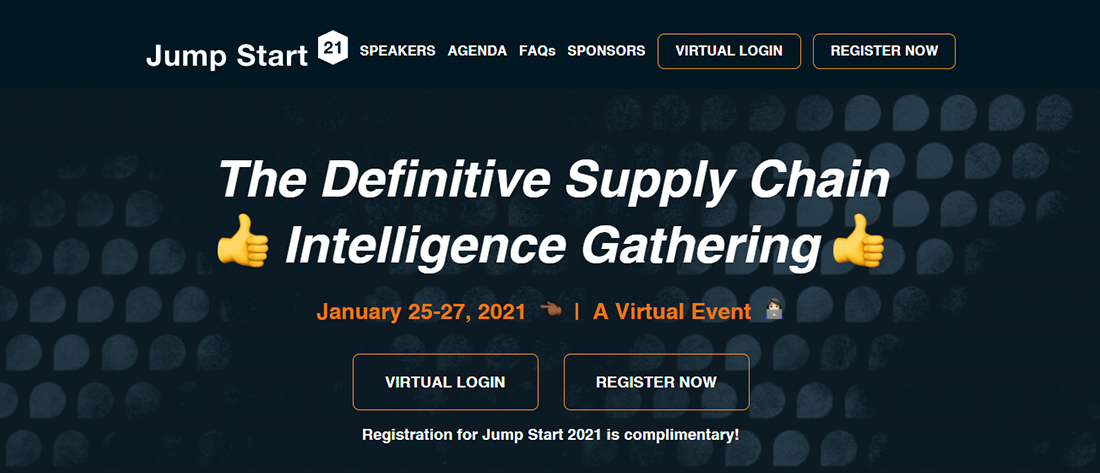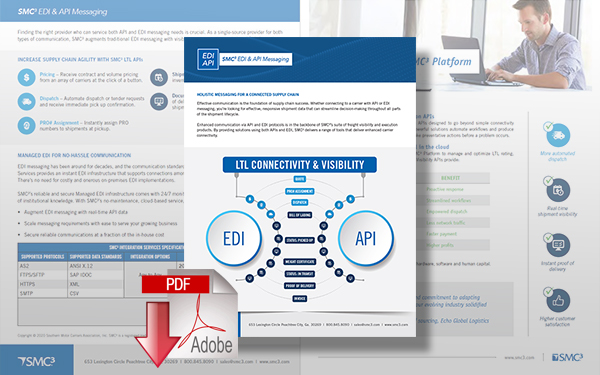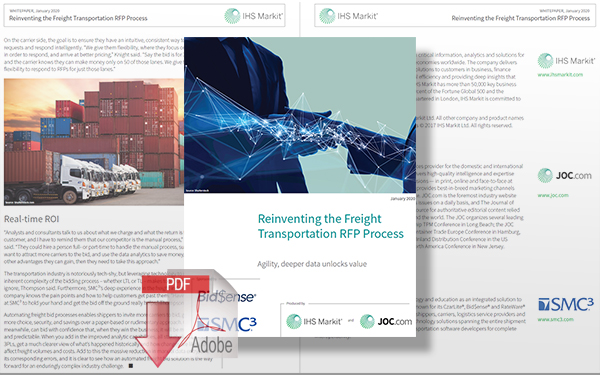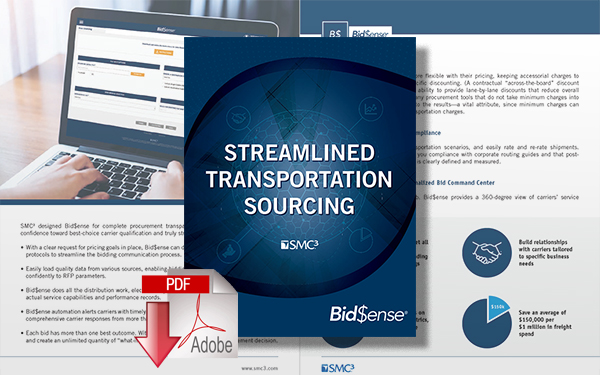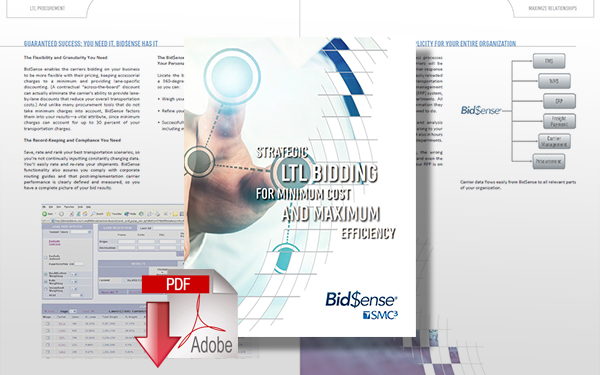SMC³ Jump Start 2021: GlobalTranz CTO to Offer Insight into Technology Opportunities in 2021

GlobalTranz Chief Technology Officer Russ Felker will discuss using logistics technology to solve supply chain pain points at SMC3's Jump Start 2021 virtual conference.
SMC³ Jump Start 2021 Virtual Conference
Jump Start 2021 will address the most pressing challenges and opportunities facing the supply chain industry in the year ahead after it experienced the single biggest disruptor in modern times during 2020.
GlobalTranz Chief Technology Officer Russ Felker (pictured above) will join FourKite’s Priya Rajagopalan to discuss using logistics technology to solve numerous supply chain pain points.
Felker recently spoke with SMC³ about how to solve some of these issues and how GlobalTranz has adapted during the coronavirus pandemic.
What were some of the pain points the industry experienced as a result of the pandemic in 2020?
Our industry has been navigating a whole host of challenges which are probably too numerous to list here. Since lockdowns began in March 2020, shippers have had to contend with a historically volatile transportation market, capacity shortages and imbalances, rapidly shifting consumer behavior, and an uncertain economy, to name but a few.
For shippers deemed “non-essential” early in the pandemic, simply staying in business was the goal. For those deemed “essential,” they could hardly keep up with demand. In addition to the well-publicized toilet paper and cleaning product shortages, we have seen huge demand increases for everything from butter to dog food. At the end of the day, this all contributed to an environment in which shippers were challenged to simply execute on the task of getting their goods to market, where and when they were needed.
Carriers experienced the other end of this market volatility, with many unable to stay in business as shipments from non-essential businesses dried up, and others, including LTL, truckload, and small parcel carriers, struggled to manage the huge shipment volumes flowing through their networks. All in all, the industry landscape has been characterized by these extremes, which we are only now starting to see normalize as we kick-off 2021.
Logistics providers, in addition to many shippers, had the impact of a mass movement to working remotely. This exposed many processes and efficiency gaps in the industry in addition to throwing long-held business models and approaches into question. This mass exodus from the office and the need to “work together apart” was something technology stepped in to help affect but continues to be a pain point for the industry as we head into 2021.
Do you think any of the solutions we’ve seen come about during the pandemic will be long-term?
The accelerated shift to e-commerce is certainly one of the trends that will last. But it’s not simply that consumers are buying more products online; it’s what they are buying that has dramatically evolved. Through the lockdown, consumers have become increasingly comfortable purchasing items online that they previously would only purchase in brick and mortar stores – big and bulky items such as furniture, exercise equipment, and more. Now that this new comfort level has been established, it’s not going away.
Shippers and carriers – and the 3PLs they partner with – are being forced to adapt to this new landscape and new customer expectations, impacting everything from delivery times (read: shorter), costs (read: free), and the delivery experience itself (read: seamless and with an emphasis on customer service and brand reputation). An important component of this shift to e-commerce is the rapid evolution of omnichannel, and the ability for retailers to offer their customers a range of purchase and delivery options. This includes buying online/pick up in-store, curbside pickup, as well as home delivery. All of this is powered, of course, by technology that gives shippers greater visibility and insights into inventory levels and locations, shipments in transit, demand signals, and more.
This is an exciting time to be a part of our industry and it will be fascinating to see how these changes play out in the short- and long-term.
How has GlobalTranz stayed connected with its customers during the pandemic? Is the use of innovative technology in the supply chain area more important than ever?
Even in “normal” circumstances, frequent communication and deep collaboration with our customers is essential to success. The pandemic simply underscored the critical nature of staying connected, and our team has used every available tool to ensure we are delivering superior customer service and solutions, from old-fashioned phone calls and the now ubiquitous Zoom meetings to more high-tech solutions such as dynamic heat maps that show the impact on rates per mile in the top 20 COVID hotspots across the U.S. (yes, we built that!).
When faced with incredibly challenging circumstances, technology innovation is more important than ever. Sometimes, that means figuring out how to be more efficient, for example, by using RPA to automate tasks. Other times, it means figuring out how to streamline development efforts in order to speed go-to-market, as we have done using no- and low-code approaches to user interface development. And sometimes it means reimagining and refreshing technology tools, as we have done with our mobile app and TMS.
Priya Rajagopalan, who is joining you on the panel, said historically, supply chains have been built around siloed workflows and semi-autonomous business units, leading to redundancy and inefficiency. How do you think technology can address this?
Information visibility is critical as is the in-process delivery of business intelligence. The siloes and separation have been able to be sustained, in some part, due to the proximal working environment enabling the sharing of tribal knowledge in a more immediate fashion. With the move to fully virtual working this model is upended and the underbelly of inefficiency and lack of documented process is visible.
Additionally, supply chains operated in a relatively stable manner. Though there were occasional, though consistent, point interruptions to supply chains, companies were able to address those interruptions via manual effort and work. A mass disruption, such as what we saw in 2020 from the pandemic, quickly outpaced the capability of manual processes to sustain outcomes. Technology needs to be employed to look at the overall sustainability and resilience of the supply chain well below immediate suppliers, but down 1-2 levels to understand not just the immediate impact of your direct suppliers, but their suppliers and their supplier’s suppliers.
Jump Start 2021 Related Articles
- SMC³ Jump Start 2021: FourKites CPO to Present Technology Solutions to Logistics Problems
- SMC³ Jump Start 2021: Women in Trucking Leader Discusses Final-Mile Delivery
You can read Priya Rajagopalan’s pre-conference thoughts here. To hear more from Russ and other industry experts, register today to attend Jump Start 2021 – a virtual free event this year!
Related Papers
SMC3 EDI & API Messaging
In this paper/datasheet/case study, we describe, whether connecting to a carrier with API or EDI messaging, you’re looking for effective, responsive shipment data that can streamline decision-making throughout all parts of the shipment lifecycle. Download Now!
Reinventing the Freight Transportation RFP Process
In this white paper, we describe how using a tech-enabled freight bid system allows for more freight providers to be considered, greatly improving choice and the ability to tailor your service around more than just price. Download Now!
Bid$ense: Streamlined Transportation Sourcing
This paper details how using Bid$ense leverages SMC³’s lifetime of transportation purchasing knowledge, allowing customers to incorporate pricing, claims ratios, on-time performance, and transit times into their LTL bidding analysis. Download Now!
Strategic LTL Bidding for Minimum Cost & Maximum Efficiency
This paper details how SMC³ designed Bid$ense for complete procurement transparency, and how you’ll move ahead with ease and confidence toward best-choice carrier qualification and truly strategic LTL procurement. Download Now!
More SMC³ Resources
Article Topics
SMC3 News & Resources
Mastering LTL Shipping: Strategies to Become the Carrier’s Top Choice Career Success in LTL: Insights from Industry Veterans Effective Strategies for Last Mile Returns in LTL Logistics SMC3 Mercury Gate Case Study - Improving Workflows and Enhancing Efficiency with LTL APIs SMC3: Is Technology a Competitive Advantage in the Modern Supply Chain Industry? Armada’s Prather examines the disconnect between the freight economy and the macro economy at SMC3 JumpStart 2024 SMC³’s Solution to the Logistics Industries Talent Problem More SMC3Latest in Transportation
April Employment Update: Trucking Sector Faces 300 Job Losses Porsche Gets Greener, Shifts to Sustainable Transport Logistics How Much Will it Cost to Repair Baltimore’s Francis Scott Key Bridge? Trucking Industry Pushes Back on Government’s Electric Mandates Maersk Sees Silver Lining in Red Sea Shipping Challenges Baltimore Opens 45-Foot Deep Channel Following Bridge Collapse El Paso Border Delays Cost Juarez $32 Million Per Day in Economic Losses More Transportation

